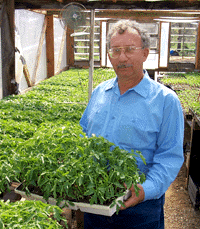Horticultural Crops Are Profitable Alternatives
Horticultural Crops Are Profitable Alternatives

Fruits and vegetables are profitable options for farmers looking for alternative crops or people seeking sources of extra income.
"A key to profitability with these crops is to know which varieties perform best under the growing conditions in a particular area," said Terry Jones, Extension horticulturist at Robinson Station, the University of Kentucky College of Agriculture's research facility near Quicksand.
Bushels of information on performance of fresh-market tomatoes, cabbage and pumpkins will be given on horticultural tours during the All Commodities Field Day July 22 at Robinson Station. The first station tour will begin at 2 p.m. The last tour will start at 5 p.m., followed by dinner at 6 p.m. In addition to horticultural variety trials, field day visitors will see a step-by-step story of hardwood flooring unfold at the Wood Utilization Center. Agronomy tours will have sessions on tobacco production and the production of livestock grain and forage.
Educational tours also will take place at Robinson Forest. Topics will include forestry evaluation and management, logging best management practices, alternative land uses for small-acreage woodlands, forest landowner rights and responsibilities, environmental education opportunities and forest management options. People going to the forest will leave Robinson Station at 9 a.m. and return by 3:30 p.m. This still will allow time to take a tour or two at the station.
"These horticultural variety trials help us identify fruit and vegetable varieties that will grow well in the area," Jones said. "These varieties also must have many qualities desirable in wholesale and retail markets. As a result of these trials, our recommendations are based on several years' experience with a variety. Plus, we know it's one the buyers will like.
"Many of these varieties also are being evaluated in identical trials near Lexington. Seeing the same results at two locations adds another degree of reliability to our variety recommendations. Plus it means the recommendations can be used in many areas of Kentucky."
The variety trials already are having a positive economic impact, according to Jones.
"A cooperative in eastern Kentucky is using varieties recommended from our trials to raise 60 acres of cabbage and 40 acres of bell peppers," he said. "Net income from the peppers normally is $3,000 an acre and from the cabbage $1,500 to $2,000 an acre -- except when there's a severe drought like we've had this year.
"We're seeing an increase in vegetable acreage from people looking for alternatives to generate income as a result of uncertainty about tobacco. The number of farmers markets also is on the rise. Many of these growers are using our research findings on what they should and shouldn't be doing to successfully produce a high-value crop."
Jones said fruit and vegetable growers don't need a large acreage to make money with these crops. "We had some people from Pike County come over here to look at our work," he explained. "They took information back to Pike County and now they're selling about $3,000 worth of tomatoes from a one-tenth-acre plot."
In fresh-market tomato trials, Jones evaluates varieties for size, fruit color, yield, disease resistance, and how well they ship. "We've seen substantial differences in some of these factors among varieties. These differences could provide growers thousands of dollars in extra profits," he said.
Because cabbage is sold for fresh or slaw markets, varieties need a dense, solid head. Other beneficial traits are disease resistance and a uniform head size.
"We're also looking for tomato and cabbage varieties that have desirable traits and also come in earlier," Jones added. "This is because producers who enter the market earlier often get a higher price. It pays to be the first on your block so to speak."
Since eye appeal is an important trait in pumpkins sold for Jack ‘o lanterns, Jones is selecting varieties that have a handle strong enough to support a pumpkin and a good green color. He also evaluates varieties for shape, color, size, storage quality and disease and insect resistance or tolerance.
"A cut-flower market for hydrangeas already exists because the florist trade imports many flowers from California and Europe," Jones said. "If our variety trials can identify plants with the color, flower head shape, and desirable stem length and strength, Kentucky could enter that market. Since it takes three years for small plants to come into flower production, this is the first year we'll be able to see many of the blooms."
One horticultural session will take place at Robinson Forest where participants will visit ginseng and goldenseal medicinal herb projects.
"Ginseng played a big part in the founding Kentucky because it helped pay Daniel Boone's expenses. Both ginseng and goldenseal are high-value crops that can have an equally important impact on modern-day Kentuckians," Jones said.
"You can raise 1,000 pounds of ginseng on an acre," he explained. "Grown as a wild simulated plant, ginseng will sell for $250 a pound. You have to be patient because it might take eight years from the time you seed ginseng until you can sell it.
"It takes four to five years after you plant goldenseal until it's ready to harvest. You can expect about 1,500 pounds per acre of planted area. Goldenseal typically brings $40 a pound."
In addition to high value, Jones said another advantage is ginseng and goldenseal are native to eastern hardwood forests that permeate the area. "Since both grow beneath the shade of trees, you can manage woodlands to grow timber at the same time you're growing these herbs," he explained. "Ginseng and goldenseal will grow on steep land so the only limiting factor is your ability to get up there and remain standing on it."
